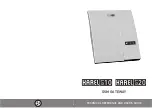
54
Chapter 6
Troubleshooting
Testing the bonded pair
There are no specific field installation test procedures for the bonded pair. The bonded
pair works properly when the appropriate i3822V LEDs light. For more information,
see “Interpreting the i3822V indicators” on page 30 and “Viewing individual DSL and
aggregate bandwidth” on page 53 to view the aggregate bandwidth.
Testing the coaxial cable
Test cable continuity on coaxial interfaces. Make sure that there is not a splitter or
bridge tap running off of the COAX home run.
Performing an HPNA test
HPNA requires one host adapter on the network at all times; however, there can be
multiple client adapters on the same network. Each receiver location is configured as
a client. The HPNA host is built into the i3822V. Using a test toolkit, you can terminate
an HPNA line into the test set and synchronize with the far-end device (for example,
the set-top box).
Perform an HPNA test to verify following:
•
The HPNA signal and MAC address are detected on each receiver on the
network.
•
The minimum readings between each set-top box and i3822V. These
measurements include:
–
Rate
–
Signal-to-Noise ratio
–
Packet loss
Isolating HPNA issues
A failure in HPNA stations indicates that at least two devices operating over a section
of coaxial cable have substantial signal loss between two or more HPNA devices. Use
these tips to isolate the issue:
•
Verify that all connectors are compression type and properly tighten it with a
torque wrench at a minimum 15 in-lb, but do not exceed 20 in-lb.
•
Verify that all splitters have been replaced with the approved splitters.
•
Verify that the i3822V coaxial cable is connected on the IN port of the splitter.
•
Use your COAX fault locator to check for the presence of a splitter, and make sure
that there is not a splitter or bridge tap running off of the COAX home run.
•
Test all cables again for excessive loss (greater than 0.5 dB per COAX run). If all
connectors have been replaced and loss is still excessive, replace the COAX run.











































